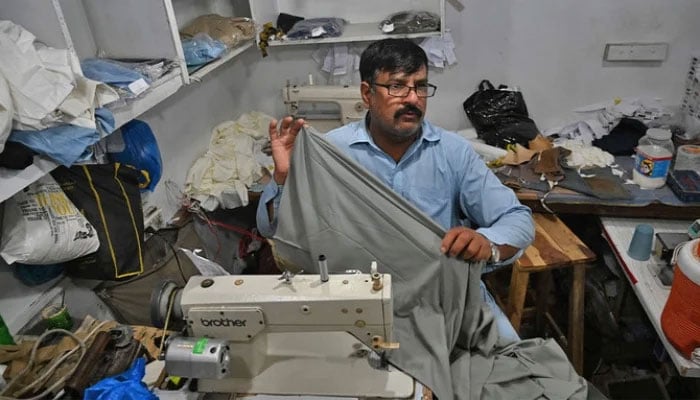Our Terms & Conditions | Our Privacy Policy
Rawalpindi tailors hold the threads of tradition
A tailor stitches a fabric at his shop in Islamabad on April 29, 2022. — AFP
In the maze of Rawalpindi’s old bazaars, where narrow alleys echo with the hum of sewing machines and the rustle of fabric, generations of tailors continue to stitch not just garments but the cultural fabric of the city itself.
“Tucked between chai kiosks and shoe repair stalls, the rhythmic vibration of sewing machines is the soundtrack to stories that rarely make headlines. Here, amidst bolts of fabric and chalk-dusted aprons, city tailors work long hours, stitching dreams, deadlines, and traditions into each seam,” says Nighat Zahra. “As the city grows more modern and globalized, tailors remain one of its most grounded professions—quietly adapting to changing fashions, rising rents, and the relentless pressure of seasonal booms like Eid and wedding season,” says Esa Zaidi.
“For us, the needle doesn’t stop. In Ramadan, we work until two or three in the morning. Now, customers also want styles. We have to keep learning,” says Muhammad Hussain, 52, who has run his modest tailoring shop in Moti Bazaar for over three decades. “From classic shalwar kameez to fusion wear that blends East and West, tailors have become unexpected trend interpreters. However, behind the evolving style lies an industry under strain. Rising inflation has squeezed profit margins. Skilled labor is migrating to the Gulf, and many apprentices leave midway to pursue ride-hailing or delivery work, which offers faster income,” says Ahad Ali.
“Tailoring is not easy money anymore. We charge by the piece, but thread, buttons, zips—even diesel for the generator—everything is more expensive. And customers still want old prices,” says Farzana Batool, one of the few female tailors running a home-based workshop in Gulzar-e-Quaid.
“From Raja Bazaar to Committee Chowk, tailoring shops line the streets. Inside, men—some elderly, others not yet out of their teens—sit cross-legged on raised platforms, surrounded by spools of thread, chalk-marked cloth, and the steady rhythm of machines,” says Dildar Hasan.
“Still, the profession is evolving. Younger tailors are incorporating digital tools, taking orders via WhatsApp, and uploading Instagram reels, displaying embroidery patterns and fabric choices,” says Bismal Fatima.
“We barely slept before Eid. We had over 300 orders, and customers still expected last-minute changes. This work is rewarding, but it comes with pressure,” says Shahzad Alvi, a 29-year-old tailor in Saddar.
“Seasonal demand creates both opportunity and exhaustion. Ramadan, weddings, and school uniform cycles drive business—but also long hours, late nights, and occasional disputes over missed deadlines or imperfect stitching,” adds Shahzad. Bushra Naqvi, one of the few women tailors running a home-based workshop in Satellite Town, says, “Despite all challenges, tailors take pride in their craft. When someone comes back saying their dress was praised at a function, that is everything. This is not just a job. It is art, in a way.”
Images are for reference only.Images and contents gathered automatic from google or 3rd party sources.All rights on the images and contents are with their legal original owners.



Comments are closed.